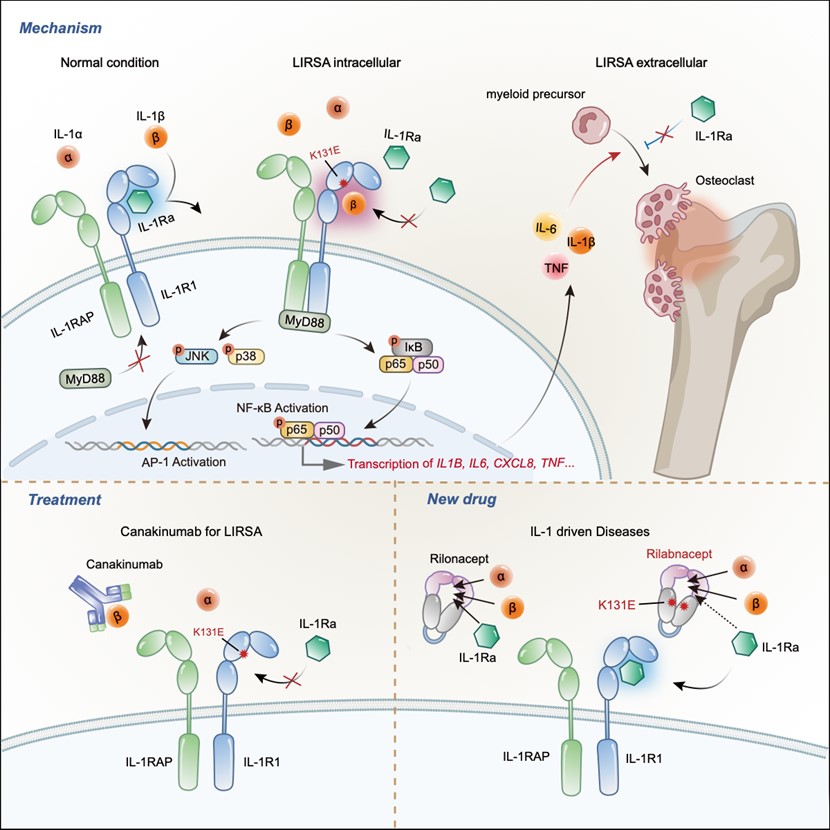Immunity:Identification of an IL-1 receptor mutation driving autoinflammation directs IL-1-targeted drug design
Source:Qing Zhou
2023-06-30
The IL-1 signaling pathway is one of the most important pathways in the orchestration of innate and adaptive immune responses. The aberrantly activated IL-1 pathway has been implicated in multiple disorders, such as rheumatoid arthritis, degenerative diseases, cardiovascular disorders and cancer. The IL-1 signaling cascade is initiated by the binding of interleukin 1 alpha (IL-1α) or interleukin 1 beta (IL-1β) to IL-1R1, which recruits the IL-1 receptor accessory protein (IL-1RAP) to form a receptor complex. Next, the signaling adaptor myeloid differentiation factor 88 (MyD88) docks to the intracellular region of the IL-1 receptor complex and mediates the activation of NF-κB and MAPK signaling pathways, leading to downstream expression of proinflammatory cytokines and chemokines. IL-1Ra competes with IL-1α and IL-1β to bind IL-1R1, thereby acting as an endogenous inhibitor of the IL-1 signaling pathway. Persistent activation of IL-1 signaling pathway caused by gene mutations leads to autoinflammatory diseases with various clinical features. Deficiency of IL-1Ra (DIRA) caused by loss-of-function mutations in IL1RN leads to unopposed activation of IL-1 signaling pathway with development of early-onset multifocal osteomyelitis and generalized pustulosis. Despite the pivotal role of the IL-1 receptor complex in regulating innate immunity and inflammation, human diseases associated with mutations in the IL-1R1 have not been discovered.
In this study, Wang and his colleagues identified a new autoinflammatory disorder caused by a novel de novo missense variant p.Lys131Glu in IL-1R1. The substitution occurred on the critical positively charged amino acid, which disrupts IL-1 receptor antagonist (IL-1Ra) binding site and results in mutant IL-1R1 resisting to IL-1Ra inhibition. The gain-of-function mutation leads to the constitutive IL-1RAP and MyD88 association with IL-1R1 upon IL-1β stimulation, and unopposed activation of the IL-1 pathway. The patient exhibits strong activation of NF-κB and MAPK pathways and overproduction of proinflammatory cytokines such as IL-1β, IL-6 and IL-8, especially in monocytes and neutrophils. Knock-in mice with Il1r1R134E/R134E presented unresponsive to IL-1Ra with upregulation of inflammatory cytokine under IL-1β stimulation and showed greater susceptibility to collagen antibody induced arthritis. They showed that dysregulated IL-1 signaling drives pathological osteoclastogenesis, which is responsible for the pronounced defect of bone homeostasis in the development of erosive arthritis or osteomyelitis observed in the patient and Il1r1 mutant mice. Based on the diagnosis, the patient manifested with chronic recurrent multifocal osteomyelitis was treated with canakinumab (anti-IL-1β) and responded quickly with ameliorated inflammation indicated by normalized inflammatory markers CRP, ESR, and SAA, decreased proinflammatory cytokines and downregulated NF-κB signaling pathway, as well as improvement of bone lesions. Moreover, this study provided a good example of new drug design of a more specific IL-1 Trap inspired by the identified mutation in patient. Based on the mechanism of the mutation, the modification on rilonacept with the K131E mutation could generate a much more effective IL-1 inhibitor as it only traps IL-1β and IL-1α but not IL-1Ra.

Together, based on data derived from patient cells, in vitro biochemical analysis, mutant mouse models and definitive clinical responses to IL-1 targeted therapy, this study not only identified a new autoinflammatory disease caused by a novel disease causal gene IL1R1, but also clarified the disease mechanisms and provided effective treatment to the patient. In addition, this designed a new IL-1 Trap which is a more potent IL-1 inhibitor for the treatment of IL-1-driven disorders based on the mechanism of the mutation. The authors designated this disease as Loss of IL-1R1 Sensitivity to IL-1Ra (LIRSA) and the new drug as rilabnacept.
In this study, Wang and his colleagues identified a new autoinflammatory disorder caused by a novel de novo missense variant p.Lys131Glu in IL-1R1. The substitution occurred on the critical positively charged amino acid, which disrupts IL-1 receptor antagonist (IL-1Ra) binding site and results in mutant IL-1R1 resisting to IL-1Ra inhibition. The gain-of-function mutation leads to the constitutive IL-1RAP and MyD88 association with IL-1R1 upon IL-1β stimulation, and unopposed activation of the IL-1 pathway. The patient exhibits strong activation of NF-κB and MAPK pathways and overproduction of proinflammatory cytokines such as IL-1β, IL-6 and IL-8, especially in monocytes and neutrophils. Knock-in mice with Il1r1R134E/R134E presented unresponsive to IL-1Ra with upregulation of inflammatory cytokine under IL-1β stimulation and showed greater susceptibility to collagen antibody induced arthritis. They showed that dysregulated IL-1 signaling drives pathological osteoclastogenesis, which is responsible for the pronounced defect of bone homeostasis in the development of erosive arthritis or osteomyelitis observed in the patient and Il1r1 mutant mice. Based on the diagnosis, the patient manifested with chronic recurrent multifocal osteomyelitis was treated with canakinumab (anti-IL-1β) and responded quickly with ameliorated inflammation indicated by normalized inflammatory markers CRP, ESR, and SAA, decreased proinflammatory cytokines and downregulated NF-κB signaling pathway, as well as improvement of bone lesions. Moreover, this study provided a good example of new drug design of a more specific IL-1 Trap inspired by the identified mutation in patient. Based on the mechanism of the mutation, the modification on rilonacept with the K131E mutation could generate a much more effective IL-1 inhibitor as it only traps IL-1β and IL-1α but not IL-1Ra.

Together, based on data derived from patient cells, in vitro biochemical analysis, mutant mouse models and definitive clinical responses to IL-1 targeted therapy, this study not only identified a new autoinflammatory disease caused by a novel disease causal gene IL1R1, but also clarified the disease mechanisms and provided effective treatment to the patient. In addition, this designed a new IL-1 Trap which is a more potent IL-1 inhibitor for the treatment of IL-1-driven disorders based on the mechanism of the mutation. The authors designated this disease as Loss of IL-1R1 Sensitivity to IL-1Ra (LIRSA) and the new drug as rilabnacept.


